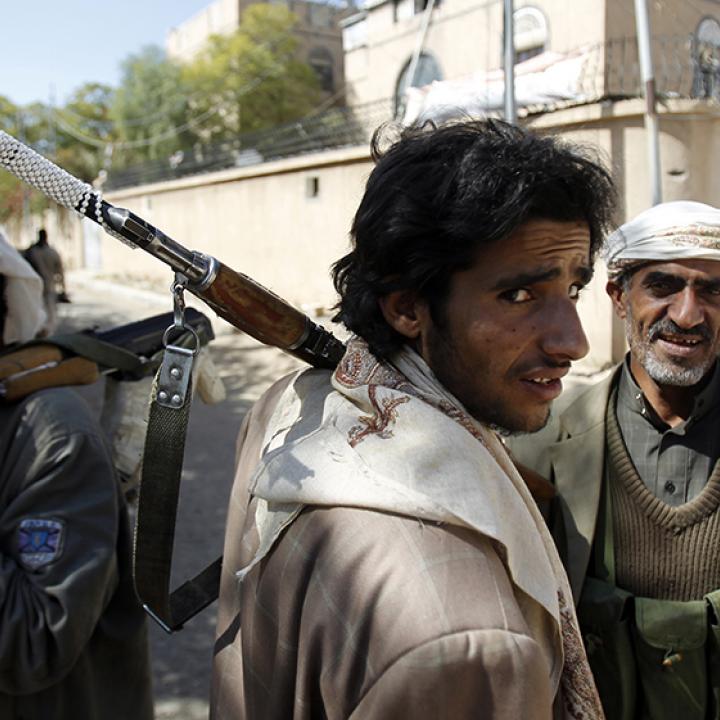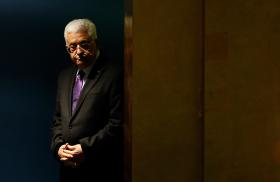
- Policy Analysis
- PolicyWatch 2733
Responding to Iran's Arms Smuggling in Yemen

Tehran is ramping up its sanction-busting military support to the Houthis, necessitating a coordinated international response to close off Red Sea access to antigovernment forces.
This week, credible evidence surfaced that Iran may be violating the UN embargo on arms transfers to the Houthi rebels, Tehran's proxy in the Yemen war. On November 29, the EU-funded group Conflict Armament Research (CAR) released a "Dispatch" paper titled "Maritime Interdictions of Weapon Supplies to Somalia and Yemen: Deciphering a Link to Iran." The group's findings give the U.S. government an important opportunity to weaken Iranian-backed militias in Yemen, demonstrate U.S. strength, and resolve the antishipping threats that have hung over the vital Bab al-Mandab Strait for months.
EVIDENCE OF IRANIAN ARMS SMUGGLING
Iran has been caught transferring weapons to the Houthis before -- notably on January 23, 2013, when the USS Farragut intercepted the ship Jihan 1 off Yemen's coast carrying 122-millimeter Katyusha rockets, radar systems, Chinese QW-1M antiaircraft missiles, and 2.6 tons of RDX high explosive. This action violated UN Security Council Resolution 1747 of 2007, which mandated that "Iran shall not supply, sell, or transfer directly or indirectly from its territory or by its nationals or using its flag vessels or aircraft any arms or related materiel." (When Iran and the P5+1 reached their nuclear deal in July 2015, UNSCR 1747 was replaced by the much weaker UNSCR 2231, which put the onus on other states "to prevent, except as decided otherwise by the Security Council in advance on a case-by-case basis, the supply, sale, or transfer of arms or related materiel from Iran by their nationals or using their flag vessels or aircraft and whether or not originating in the territory of Iran.")
By continuing such activities today, Iran may be violating the post-2014 resolutions restricting arms transfers to the Houthis and their local allies, the supporters of former Yemeni president Ali Abdullah Saleh. UNSCR 2140 (February 2014), UNSCR 2216 (April 2015), and UNSCR 2266 (February 2016) call on member states to "take the necessary measures" to prevent such transfers.
CAR based its latest findings on evidence from a range of sources, including photographs verified by the Australian government showing materiel that the frigate HMAS Darwin seized from an Iranian-made dhow in the Arabian Sea on February 27, 2016. CAR also received photos and a complete list of serial numbers for weapons that the French frigate FS Provence seized from an Iranian-made dhow off the coast of Oman on March 20. The group sent requests through multiple U.S. government channels for similar information about a March 28 arms seizure by the USS Sirocco, but all were refused.
Separately, CAR received access to two other weapons caches with suspected links to Iran. One cache was shown to investigators in October by the United Arab Emirates Presidential Guard, which claimed to have captured them from Houthi fighters in Taizz, Yemen. The group also received access to weapons that the guard claimed were seized in September in Safir after being smuggled overland into Yemen via Oman. CAR used serial numbers and weapon types to draw several important conclusions about their origin, including the following:
- Iranian-produced RPGs were found on multiple vessels. The Darwin intercepted 100 Iranian-made RPG-7-pattern rocket launchers, which CAR noted "are identifiable by their olive green furniture, cylindrical rear firing grips, and yellow serial numbers." Photos taken during the Sirocco seizure show similar launchers that CAR asserted are "consistent with Iranian production."
- New sniper rifles may have been drawn from Iranian national stocks. The Provence seizure included 64 new-condition Hoshdar-M (SVD-pattern) sniper rifles and 2,000 new-condition AKM-pattern assault rifles, all with serial numbers in sequential order. According to CAR, such a large cache of new, sequentially numbered weapons "suggests that the rifles derived from a national stockpile, rather than disparate non-state sources."
- Tehran may have supplied Russian and Iranian antitank guided missiles. The Provence found nine Russian-made 9M133-1 Kornet ATGMs manufactured in two production lots in 2008; the Kornet is a common weapon in Iran's arsenal. The UAE showed CAR a similar Russian-made Kornet reportedly captured from the Houthis in Taizz on November 29, 2015. The serial number on the latter weapon placed it in the same production batch (Lot 02-08) as the Kornets found by the Provence, providing a potential "smoking gun" linking Iranian smuggling vessels with frontline Houthi fighters. In addition, the UAE's Taizz cache included a 2015 Iranian-made Dehlavieh ATGM (an Iranian copy of the Kornet), while the Oman cache included an Iranian-made Tosan ATGM (Iran's copy of the 9M113 Konkurs).
According to CAR, "The presence of large consignments of weapons on board the dhows, a significant proportion of which were manufactured in Iran, suggests that Iranian entities may have been involved in their supply." The group added that the weapons found by the Australians and French "were probably supplied with the complicity of Iranian security forces. The new-condition weapons resembling Iranian manufacture with consecutive serial numbers, in addition to the prevalence of Iranian-manufactured RPG-7-pattern rocket launchers, supports this assertion."
CUTTING OFF THE WEAPONS FLOW
In July 2015, President Obama stated, "It is in the national security interest of the United States to prevent Iran from sending weapons to...the Houthis in Yemen that accelerate a civil war there." Today, however, Iranian ATGMs give the Houthis greater ability to resist the internationally backed government's efforts to retake the capital. Meanwhile, Iranian-supplied antishipping missiles may have been used recently against U.S. naval vessels in the Bab al-Mandab Strait, triggering American missile strikes on Houthi maritime radar facilities on October 13. Therefore, the need to decisively check Iran's seemingly escalating arms transfers has become more urgent than ever.
The first step should be a more open U.S. approach to sharing intelligence on Iranian smuggling activities. Washington's unwillingness to cooperate with the CAR investigation -- in contrast to France and Australia -- poses alarming questions about U.S. commitment to the UN-mandated Yemen blockade, particularly since UN sanctions technically require unclassified supporting information before they are enforceable. Hence, the administration should fully share the findings from its weapons hauls with the international community. For example, revealing the details of the March Sirocco seizure would help fill in gaps and clarify potential trends in CAR's findings from the Australian and French seizures. Washington should also publicize its findings on the weapons systems used to attack U.S. warships in the Bab al-Mandab on October 9 and 12; the same should be expected of the multinational investigation into the October 1 attack against the Emirati ship Swift.
If the Obama administration continues to underplay Iran's role in the Yemen conflict, it may drive the Saudi/UAE-led Gulf coalition to take actions that have potentially serious diplomatic and humanitarian effects, which the United States would be less able to mitigate if it "leads from behind." For example, the coalition could decide to tighten the naval blockade on the Houthi-controlled ports of Hodeida and Mokha, or even attack the ports directly. The former move would likely exacerbate humanitarian suffering, while the latter would constitute a major escalation and perhaps scuttle the ongoing peace effort. Either scenario would ratchet up pressure on Washington to rein in its Gulf allies. In short, avoiding the issue of Iranian arms transfers will not make the problem go away: it will only intensify the fallout.
To get ahead of this issue, the United States should strengthen its public warnings to Iran about arms transfers and back these words up with increased naval interdiction of suspect vessels. At the same time, it should engage the Omanis on bolstering their border security at sea and on land. Washington should also seek to broaden the sanctions outlined in UNSCRs 2140, 2216, and 2266 so that they prohibit all arms transfers to all Houthi and pro-Saleh forces, not just to specific leaders. In addition, the administration could consider using its domestic authority under Executive Order 13611 to sanction those involved with transfers.
Finally, if the Yemeni government and its Gulf coalition allies do choose to liberate the Red Sea coast and ports, the United States should provide intelligence and logistical support so that the operation is as quick, clean, and humane as possible. This may even mean joining with coalition partners in destroying Houthi antishipping missile batteries if they pose a threat to the effort. Washington could then take advantage of the presumed goodwill generated by its support, pressuring the Yemenis into quickly reopening these ports to civilian supplies under international supervision to avert a greater humanitarian crisis.
Michael Knights is a Lafer Fellow with The Washington Institute.



